Nuclear icebreakers – what’s so special about them?
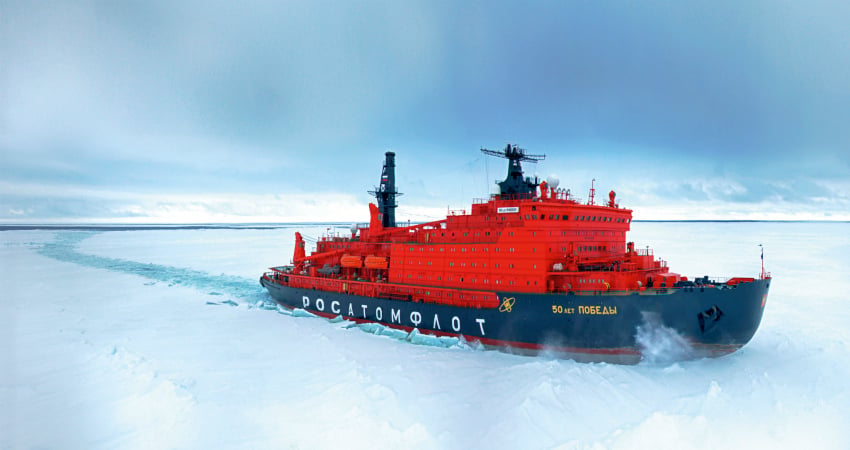
The Arctic Ocean mostly consists of scattered islands and vast icescapes. Marine navigation in the polar regions demanded a special kind of vessel to conquer the remote seas from the time of the earliest expeditions. Explorers’ ships rarely encountered open water and mostly became stuck in the ice, with no other option except to drift with it often farther away from their goal or even for the ship to be crushed completely. The need for a vessel that could clear a path and break the ice was first met in 1957 when the first icebreaker ship was built by the Soviet Union. It was also the world’s first nuclear-powered surface ship.
What is an icebreaker and how does it break the ice
For a ship to be considered an icebreaker, it has to have three features most normal ships lack: the power to push through thick ice, a strengthened hull, and an ice-clearing shape. That enables icebreakers to plow through the pack ice or frozen waterways.
In order to break the ice effectively, icebreakers must be very powerful, relatively short, wide, and extremely heavy. Icebreakers break the ice by using momentum and power to push their bow up on the ice. The ice is pushed down by the weight of the ship, which causes the ice to break off in chunks. The broken ice is then pushed out of the way by the hull of the icebreaker as it proceeds forward.
Icebreakers are specially designed for this and have sloping bows, heavy displacement (weight) for their size, and lots of power. In addition, they are specially reinforced to handle the force of the ship hitting the ice at speed. The hull is very thick and constructed from steel that can resist low temperatures. At the same time, to be able to maneuver in the icy waters, icebreakers have sloping sides and stem.
Additional strengthening is required for the bow, as it is primarily used to cut through the ice and encounters it first. While other vessels feature a pointed bow, icebreakers have a more rounded structure that helps the vessel ride over the ice and push it down with its weight.
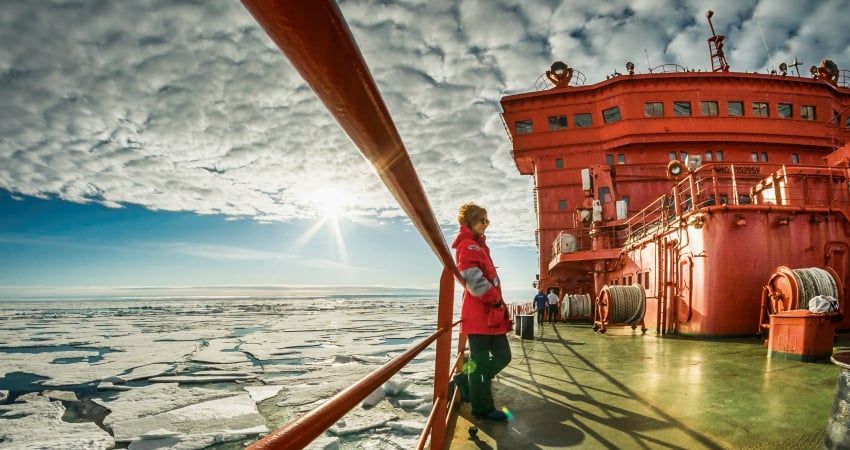
An icebreaker also has to be much more powerful than regular ships to be able to efficiently perform its duties. In the earlier period, coal and oil-fired steamships were used, later replaces by diesel-electric and nuclear-powered icebreakers.
The history of nuclear-powered icebreakers
Russia, or the Soviet Union, is the only country constructing nuclear-powered icebreakers in the world. They were purposely built for the strategic importance of the Northern Sea Route and a more evident need to guarantee the safety of the Russian trade vessels in winter and Arctic settlements’ dependency on supplies.
About 30 years ago, more than fifty Soviet ship caravans became trapped in the ice in the eastern Arctic region. Many Russian settlements depended on the cargo and food which was supposed to be delivered by the ships, and the situation itself posed danger to the crew. Luckily, among the fleet was the nuclear icebreaker ship Lenin. Due to its power and the nuclear fuel source, Lenin saved hundreds of lives in one of the biggest and most successful rescue missions in history.
Lenin was taken out of operation in 1989 and laid up at the base for nuclear-powered icebreakers in the Murmansk Fjord, later to become a museum.
Arktika class icebreakers
Arktika-class icebreakers were the next project realized after the importance of such vessels became undoubtedly. Six out of ten Russia’s nuclear civilian ships currently belong to this class. The first four of the class are retired, with two remaining in service as of 2020.
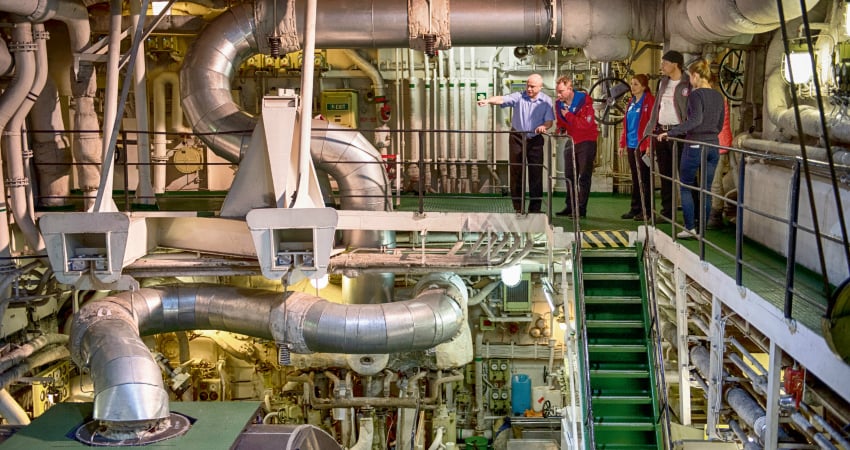
These icebreaker ships feature a double hull, the outer being about 48 mm thick at the ice-breaking areas and 25 mm thick elsewhere. Between the inner and outer hulls, there is a water ballast, able to shift its place to aid icebreaking. Arktika-class ships can break the ice while making way either forwards or backwards. Although they have two reactors, normally only one is used to provide power, with the other being maintained in a standby mode.
A nuclear-powered icebreaker can serve several purposes. These vessels have been used for a number of Arctic scientific expeditions, and regularly force cargo ships and other vessels passing along the Northern Sea Route through the ice. The main feature which makes these wonders of shipbuilding so special is their almost complete independency from any traditional fuel whatsoever, therefore they can operate autonomously for almost 70 years.
50 Years of Victory nuclear-powered icebreaker
“50 Years of Victory” is the translation for Russian “50 Let Pobedy”. The 50 Years of Victory is the newest in the seven-ship series of Arktika class nuclear-powered icebreakers. Built by Baltic Shipyard and Admiralty Shipyard in St. Petersburg. The construction of the ship began in October 1989 at the Baltic Shipyard but was halted in 1994 due to funding problems before resuming in 2003. The icebreaker took almost 18 years to complete and was finally ready for service in the beginning of 2007.
The ship is an upgraded version of the Arktika Class icebreaker and was designed with a double hull and a spoon-shaped bow. The shape of the vessel increases icebreaking capabilities and the hull is coated with polymer paint to reduce friction. It has an overall length of 160m, a beam of 30m, a draft of 11m, and a depth of 17.2m. Its displacement is 25,840t. The ship can break through ice up to 2.8m deep at a steady speed.
In the Arctic Ocean, the icebreaker can reach any point during any season of the year. According to the shipbuilder’s specification, the ship can move along freely breaking through flat ice of up to 2.8 meters (9.2 feet) thick. But the vessel is generally not encountering flat ice all the time; ice ridges may reach 5 to 20 meters in thickness (16 to 65 feet), and the icebreaker can pass through these, not with a steady motion, but rather cutting up the ice like an axe chopping wood: slowly, chopping one piece, then another. The vessel’s superstructure is solid and stable, and it’s capable of this approach.
The Victory is fitted with a digital automated control system. The biological shielding complex was modernized and an ecological compartment was added. The ship has a helipad suitable for a MI-2 or MI-8 helicopter. The ship’s propulsion plant includes two reactors: one to provide power and the other kept in standby mode.
Traveling to the North Pole aboard an icebreaker
During the brief summer, you can seize your once-in-a-lifetime chance to travel aboard this working icebreaker to the geographic North Pole. With our fleet of extremely capable landing craft, you will experience the Arctic wilderness and amazing wildlife of Franz Josef Land up close during shore excursions and Zodiac cruises. One of the most memorable highlights of your North Pole cruise will be your time aboard the helicopter, flying over and alongside the icebreaker while it plows through the frozen Arctic Ocean.
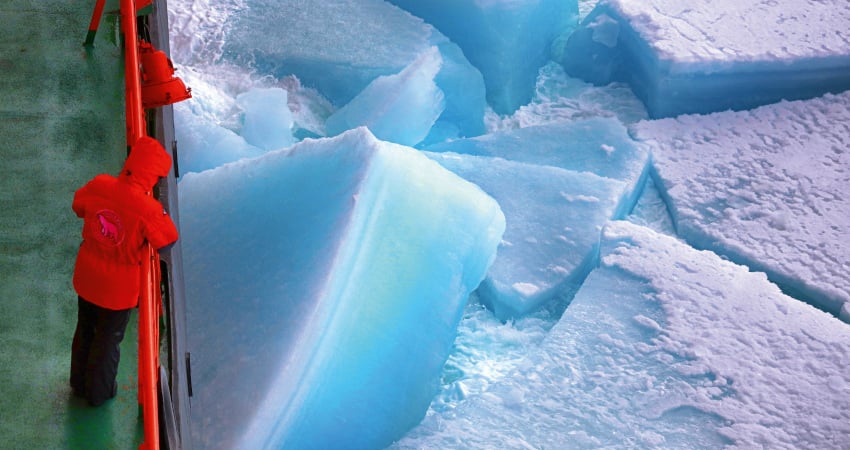
At the top of the world, you will disembark directly onto the ice to celebrate your achievement with new friends, delicious food, and hot drinks at the world’s northernmost BBQ feast. Also during your day at the North Pole, you will have a chance to demonstrate your bravery by jumping into the bone-chilling waters of the Arctic Ocean through a hole in the ice.
Comprehensive interpretation of Arctic wildlife and polar exploration will be given by our expert naturalists, scientists, and historians during riveting multilingual presentations and informal discussions on board. Our passionate expedition staff is always on hand to make sure your expedition experience is educational as well as entertaining.
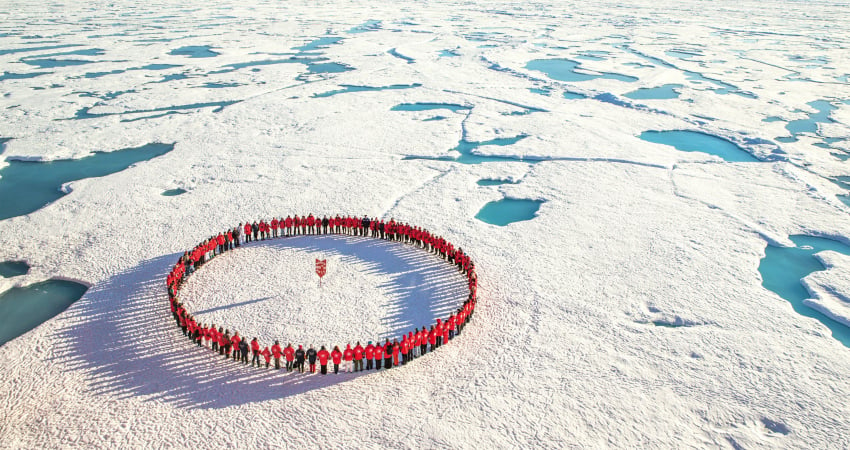
During your voyage, you will have a once-in-a-lifetime opportunity to see the inner workings of a nuclear-powered icebreaker, one of the greatest engineering marvels of the nautical world. You will go deep inside the ship to see firsthand how atomic fission is harnessed to take you safely and cleanly through the solid sea ice to the North Pole.
Traveling to the North Pole is a once-in-a-lifetime experience that will be complete with being aboard a masterpiece of engineering – the most powerful icebreaker in the world, 50 Years of Victory.